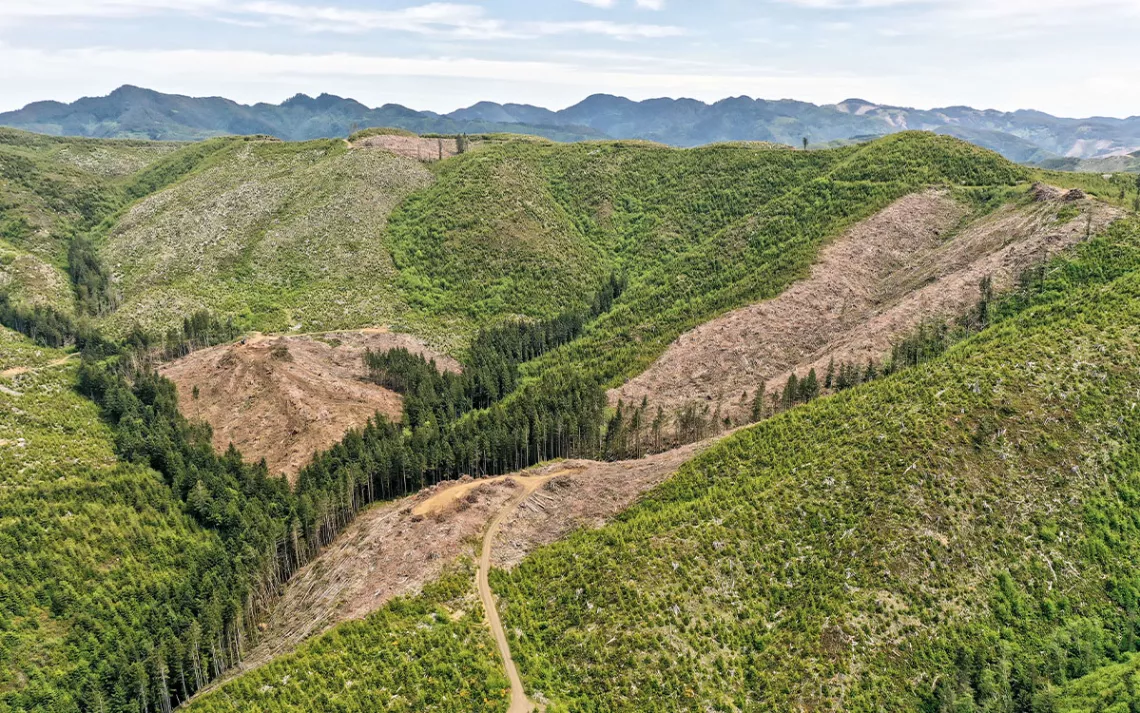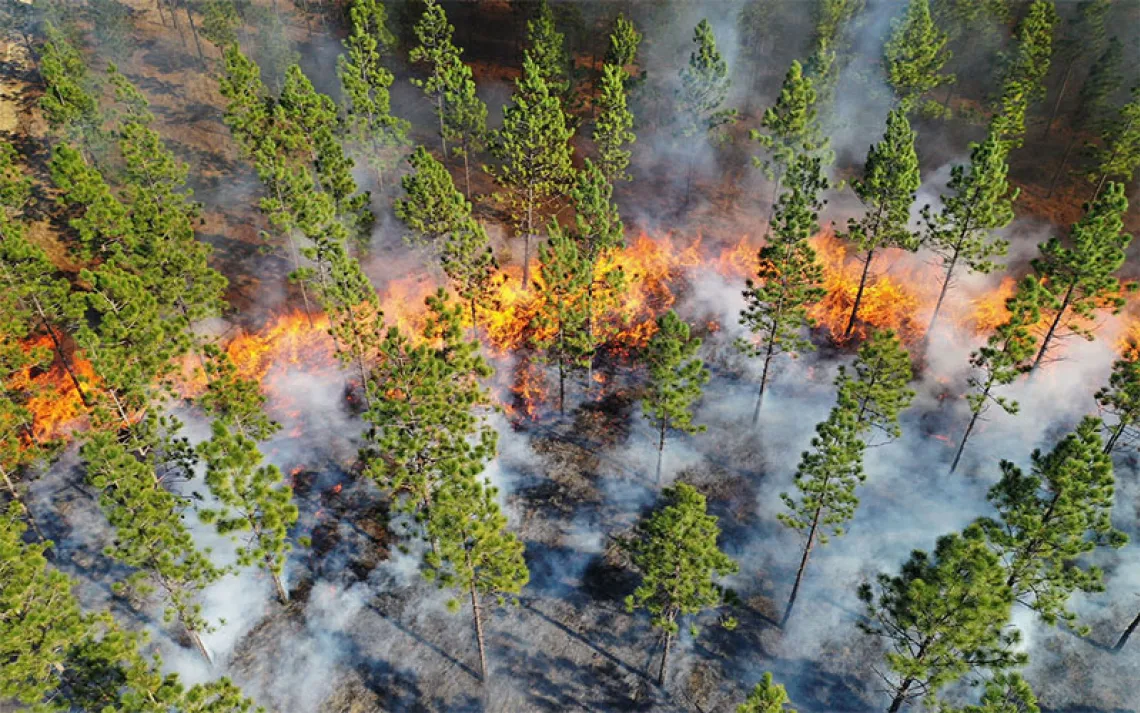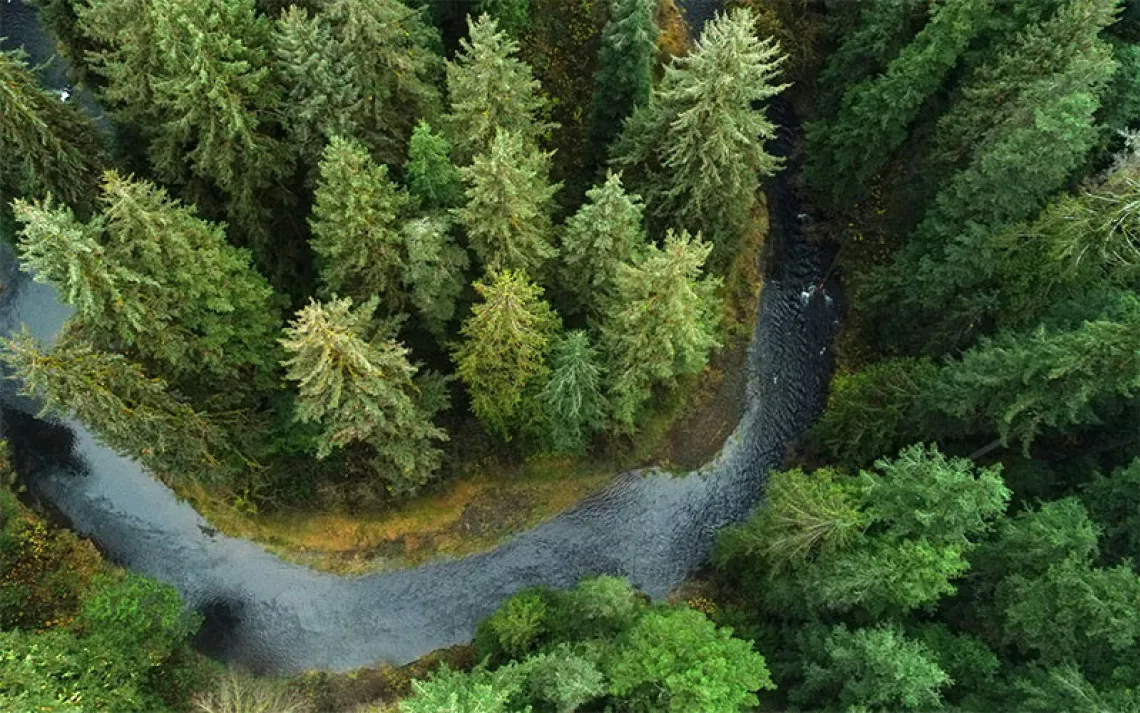Oregon’s Drinking Water Is at Risk From Clearcutting
NASA report confirms concerns about logging in watersheds and spurs community efforts to buy them

A clearcut area called Olympic Line, where logging was completed in 2021. | Photo by Trygve Steen
The Oregon Coast Range is a 200-mile-long sliver of low-elevation mountains that runs along nearly two-thirds of the state’s latitude. It is one of the wettest regions in the state, receiving 80 or more inches of precipitation a year. This heavy rainfall, coupled with the region’s mild oceanic climate, makes its forests highly productive and extremely profitable. Yet regardless of how much water the area receives, this pursuit of profit has degraded the quality of drinking water, according to local residents and environmentalists.
The forests that blanket the foothills of the Coast Range are crucial to holding onto freshwater and keeping it drinkable. But for years, local residents have suspected that clearcutting by private logging companies in the area has endangered their precious freshwater resource. Now, a new joint report from NASA and Oregon-based nonprofit Oregon Wild confirms coastal residents’ observations and echoes their concerns.
The report found “widespread” logging throughout the Oregon Coast Range, concluding that “conventional logging practices pose a risk of contamination to surface water quality.”
The report’s authors arrived at this conclusion by analyzing over two decades of satellite imagery of forested land in 80 Oregon Coast watersheds connected to municipal drinking water sources. The analysis determined that from 2000 to 2022, a total of 31 percent of the land area in the study’s 80 “drinking watersheds” had been impacted by logging. The vast majority of this logging involved clearcutting on private lands. In total, 26 percent of the report’s watersheds had been clearcut. This adds up to about 585 square miles of leveled forests in Oregon’s Coast Range.
“I think people sometimes forget how much clearcut logging we actually do in Oregon,” said Erik Fernandez, wilderness program manager for Oregon Wild.
According to Fernandez, coastal watersheds are uniquely vulnerable to water-quality issues, even when they receive sufficient precipitation. Coastal watersheds are also often small and frequently cut off from larger sources of water.
“From a watershed perspective, the [Oregon] Coast Range is different. The watersheds for towns often start just above town and then flow into the ocean,” Fernandez said. “When you clearcut, you get these big exposed mountainsides. And when rain comes, a lot of that soil ends up going down into the creeks and into someone’s drinking water.”
The problem of washed-out soil ending up in drinking water is called “turbidity” by regulators and scientists. This murky mix typically carries higher levels of disease-causing micro-organisms. It’s worth noting, however, that the NASA/Oregon Wild report only suggests that clearcutting poses a risk to drinking water quality. The report does not show a clear connection between turbidity and logging in the watersheds it examined. But not because it tried and failed. It just didn’t look for one. Joseph Spruce, a research scientist and independent consultant, acted as the report’s science adviser for NASA. He says project participants had initially discussed investigating what impacts logging might have on drinking water quality, but this proved unfeasible given time and budget constraints.
“I think there is additional work to be done on water quality,” Spruce said, adding that an additional satellite analysis could be performed in the future to examine turbidity and erosion issues.
Spruce added that the nature of the program limited the amount of time available for a larger analysis. Although the NASA/Oregon Wild report didn’t look for a connection between logging and water-quality issues, it didn’t really need to. The State of Oregon has been tracking the issue for decades and already knows what watersheds are problematic. One of those watersheds is Jetty Creek, which supplies water to the town of Rockaway Beach. From 2000 to 2022, 78 percent of Rockaway Beach’s watershed was logged, according to the NASA/Oregon Wild report, making it the most heavily logged watershed observed. Unsurprisingly, Rockaway Beach has also had numerous well-documented water-quality issues since logging began two decades ago, according to Oregon state government reports.
The most recent official report to highlight Rockaway Beach’s water woes is an Oregon Secretary of State Audits Division report issued earlier this year. Citing previous state reports, the Audits Division report notes that from 2005 to 2014, Rockaway Water and Sewer, the city’s sole water supplier, issued 19 alerts to its water customers. The report also noted that Rockaway Beach residents received multiple notices that their drinking water had exceeded Environmental Protection Agency limits for trihalomethanes. These are formed when chlorine used to disinfect turbid drinking water reacts with naturally occurring organic compounds found in the water. Research has linked long-term exposure to trihalomethanes to various forms of cancer, including brain, colon, and bladder cancers. Rockaway Water and Sewer spent millions to upgrade the filtration system on its water-treatment plant to deal with high turbidity issues.
None of this is surprising to Rockaway resident Nancy Webster, who started the North Coast Communities for Watershed Protection. Webster began compiling information on the Jetty Creek Watershed following an encounter she had with a logger while hiking though a clearcut site in the foothills overlooking her home. “The logger said, ‘Lady, this your drinking water source. This type of logging is not good for it,’” Webster remembered.
Webster said that Jetty Creek, which flows through the watershed before reaching the ocean, has often visibly suffered from turbidity issues following logging. “I’ve seen Jetty Creek run the color of chocolate milk at times,” Webster said.
The NASA/Oregon Wild report highlights what is a much larger problem with water quality nationwide, according to Nina Bell, executive director of the nonprofit environmental law firm Northwest Environmental Advocates.
“Americans in general are very concerned about water quality, and I think if they had any idea how poor the protections really are, they would be very unhappy with the lack of action and the expensive use of federal and state tax dollars,” Bell said. Communities that experience logging in their watersheds don’t have a lot of legal ground to stand on if they attempt to sue using the Clean Water Act if their towns’ watersheds are privately owned, she added.
This is why organizations like hers have focused on suing state and federal agencies for failing to enforce the Clean Water Act. And while she has had some success, in her own experience the State of Oregon has failed to meet its Clean Water Act obligations. In fact, following a lawsuit brought by Bell and her organization, the Oregon Department of Environmental Quality has been penalized by the federal government for failing to meet water-quality standards under the Clean Water Act due to current logging practices in the state. The lawsuit has resulted in the state being denied nearly $11 million in federal funding from 2015 to 2023 due to violations, according to documents provided by Bell.
“The State of Oregon, meaning all the different agencies, have addressed the impacts of pollution on drinking water with the same distain as they have addressed those impacts on water quality in general,” Bell said.
Mike Broili, chair of the Officers Board of the MidCoast Watersheds Council, also thinks a huge part of the problem is the private ownership of watersheds. “When the forest within a community’s watershed is owned by an outside entity, which is the case in many of our watersheds, these entities can just decide that they’re going to log, and the community has little to no say in it,” Broili said.
The MidCoast Watersheds Council oversees ecological restoration efforts aimed to benefit both salmon and people in six coastal waterways along Oregon’s central coast. NASA’s analysis confirms Broili’s concerns. The NASA/Oregon Wild report found that clearcutting was far more common on private land than state or federal land. What’s more, the report continues, most of the cutting was on large lots owned by outside companies. Logging on locally owned and tribally owned land accounted for just 2 and 0.2 percent, respectively.
This is why Broili, Webster, and Fernandez are trying a new strategy. They think Oregon’s coastal communities should own their watersheds, and they’re hoping to get Oregon lawmakers involved. Fernandez said Oregon Wild plans to use its joint report with NASA and the data associated with it to make the case that Oregon needs new legislation that could help fund community efforts to buy drinking watersheds. Though this legislation could take a while to develop and pass.
Webster said Rockaway Beach is considering buying the Jetty Creek Watershed from the company that currently owns it. She also supports new legislation that could make this buying process easier for communities like hers and has plans to be a part of the lawmaking effort. Through her group and others like it, she hopes to build a larger network of concerned residents that could build momentum for the effort.
“You can feel pretty powerless,” Webster said. “So, what we are trying to do is connect with other small watersheds like ours.”
 The Magazine of The Sierra Club
The Magazine of The Sierra Club



